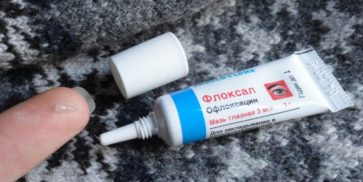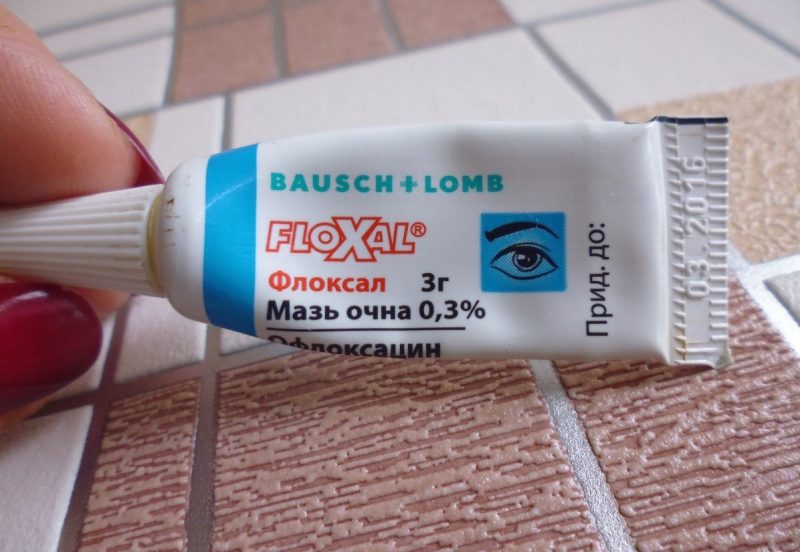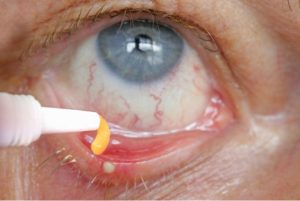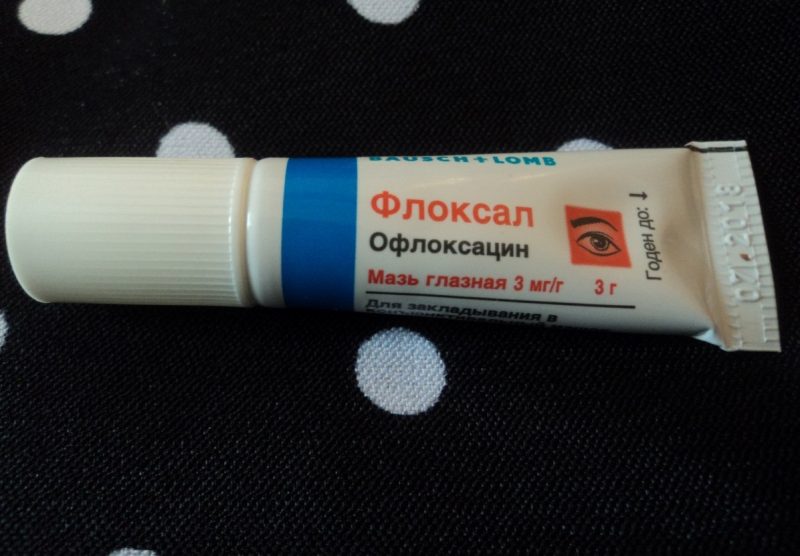Phloxal ointment is an antibacterial drug that belongs to the group of fluoroquinolones. It is used in the treatment and prevention of inflammatory eye diseases resulting from an infection.
Material Content:
Release form and composition of funds
Phloxal is produced in the form of ointments and eye drops. It is also available in tablets.
Ointment for the eyes is stored in tubes of aluminum with a volume of 3 grams. The tube is placed in a cardboard box, there is a detailed instruction. A special nozzle goes to the ointment, which is used to squeeze the product out of the eyelid.
The product itself, located in the tube, has a uniform consistency and a pale yellow color, there is no smell.
1 g of ointment contains 3 milligrams of ofloxacin - an antibacterial drug, which is the active substance. It also contains various auxiliary substances (petroleum jelly, paraffin and others).
Useful properties and pharmacological action
The main component of the drug, as mentioned above, is an antibiotic from the fluoroquinol group - ofloxacin. This antibacterial drug is resistant to the damaging effects of beta-lactamase, an enzyme that many microorganisms that cause eye diseases produce. Because of it, other antibiotics (for example, penicillin) have no effect in ophthalmic diseases.
The drug Phloxal has an effect mainly on gram-negative microorganisms (in particular, chlamydia and mycoplasma).Of the gram-positive pathogens, staphylococci and streptococci are sensitive to this agent.
The pharmacological effect of this drug is due to its effect on the enzyme DNA gyrase of pathogenic microorganisms. This leads to the destruction of DNA and the destruction of the bacteria themselves.
Due to these properties, the drug is successfully used for blepharitis, conjunctivitis, keratitis, from barley in the eye and other ophthalmic diseases.
Instructions for use ointment Phloxal
The tool is used for therapeutic and prophylactic purposes. Dosage and duration depend on many factors, including age.
For children
The tool can be effectively used for the treatment of childhood ophthalmic diseases. In the treatment of children, Phloxal is not used in a standard dosage, but in a doctor's prescription. The course lasts no more than 14 days. The best way to use the product in children is to put it over the eyelid three times a day. A strip of ointment should be no more than one centimeter in length.
For adults
The duration of treatment and the required dosage of the drug is determined by the ophthalmologist individually for each person, taking into account the nature of the course of the disease and the type of pathogen.
- Eyes must first be cleaned. The eyelid should be treated with warm boiled water in the direction from the outer corner of the eye to the inner. Each eye is wiped with a separate cotton swab so as not to increase their infection. If the treatment procedure is carried out for preventive purposes, then this part of the process can be excluded.
- Before working with the ointment itself, it is important to wash your hands very thoroughly with soap. Next, the lower eyelid is drawn off, and an ointment is applied to the mucous membrane with a thin strip (about 1.5 centimeters long). The eye should be closed and gently massage the eyelid with your finger, using circular movements to better distribute the product.
- Adults require three procedures per day, and with chlamydial lesions, the amount increases up to 5 times. The duration of the course of Phloxal therapy is 3-5 days, in special situations the doctor can extend the treatment to 7 days.
If an eye ointment with an antibiotic is used as a prophylactic for traumatic injuries or after surgery, then a single application is sufficient.
During pregnancy and breastfeeding
Phloxal ointment is forbidden to use in the first three months of pregnancy, since a certain amount of ofloxacin, getting into the systemic circulation, can disrupt the growth and development of vital embryo systems.
It is recommended to use the drug in the 2nd and 3rd trimesters only in individual situations, if the benefit for the woman exceeds the possible risks for the baby.
Also, do not use antibacterial eye ointment when breastfeeding. Studies aimed at identifying the ability of ofloxacin to pass into breast milk have not been conducted. Therefore, if the use of the drug is necessary, then at this time, breastfeeding should be interrupted.
Interaction with other drugs
Before using Phloxal in combination with other eye preparations, you must wait 5 minutes after applying the previous medication. It is important to remember that the ointment is combined only with products manufactured in the form of a solution.
People who use contact lenses are advised to abandon them for the entire period of treatment.
Interactions with other drugs are more relevant for Phloxal in the form of tablets. This is due to the fact that with local use of the drug its content in the blood is quite low and rarely causes adverse reactions.
- The combined use of drugs containing ofloxacin and glucocorticoids increases the risk of tendon rupture.
- Using them simultaneously with non-steroidal anti-inflammatory drugs can also lead to undesirable consequences.
- The antibiotic Ofloxacin inhibits the utilization of theophylline from the body. In this regard, with their simultaneous use, it is necessary to use theophylline in lower doses.
- Also, the drug cannot be used together with heparin and vitamin K antagonists, as this can lead to changes in blood coagulation.
- The use of Phloxal along with preparations for alkalizing urine can cause kidney inflammation.
Contraindications, side effects and overdose
Drugs containing ofloxacin are contraindicated in case of individual intolerance to fluoroquinolone antibiotics. Also, the ointment can not be used if you are allergic to other components that make up its composition.
It is forbidden to use the product during pregnancy and breastfeeding. The reasons for this limitation were discussed above.
The occurrence of side effects during the use of Phloxal is a rare occurrence. Unpleasant consequences are usually observed in individuals with high sensitivity to individual components of the drug.
Symptoms are as follows:
- burning sensation;
- mucous eyes become redder;
- swelling of the eyelid tissue occurs
- there is a feeling of the presence in the eye of a foreign object;
- short-term decrease in visual acuity;
- the appearance of a rash in the eyelids;
- lacrimation
- sensitivity to light;
- dizziness;
- nausea;
- Quincke's edema (extremely rare).
There were no cases of overdose during the use of eye ointment. But with a significant increase in the prescribed dose, discomfort may appear in the form of itching, burning, pain in the eyes.
Such symptoms do not require special treatment. It is recommended that you simply rinse your eyes with running water. If the unpleasant sensations are tolerable, then you can just wait for them to disappear in a few minutes.
Analogs
Phloxal eye ointment has several analogues in the form of an ointment:
- Ofloxacin. Contains the same active substance as Phloxal. In this regard, the identical effect of the application appears.
- Erythromycin ointment. The active substance is the antibiotic erythromycin (a group of macrolides). It acts on almost all gram-positive microorganisms. This drug is most effective for eye diseases caused by ureaplasmas, chlamydia or mycoplasmas.
- Lacropos. This drug is based on the polymer component carbomer, which is a combination of water with polyacrylic acid. The substance replaces the tear film, thus protecting the eye from the effects of harmful environmental factors. In addition, the drug has a therapeutic effect, without penetrating into the deeper structures of the eye.
- Tetracycline ointment. This tool can be considered a cheaper analogue of Phloxal. It includes an antibiotic that has many useful properties. The drug has a bacteriostatic effect on microorganisms susceptible to it, preventing their division. Almost all staphylococci, streptococci, salmonella, rickettsia, clostridia, gonococci, pneumococci, mycoplasmas and chlamydia are sensitive to this remedy. Therefore, the ointment is prescribed quite often. However, this drug does not cope with Pseudomonas aeruginosa, Proteus, fungus and a huge number of viruses.
Phloxal is an effective remedy for many inflammatory diseases of the eye. The tool has few contraindications and practically does not give side effects, so it can rightfully be called one of the best drugs for the eyes.






















